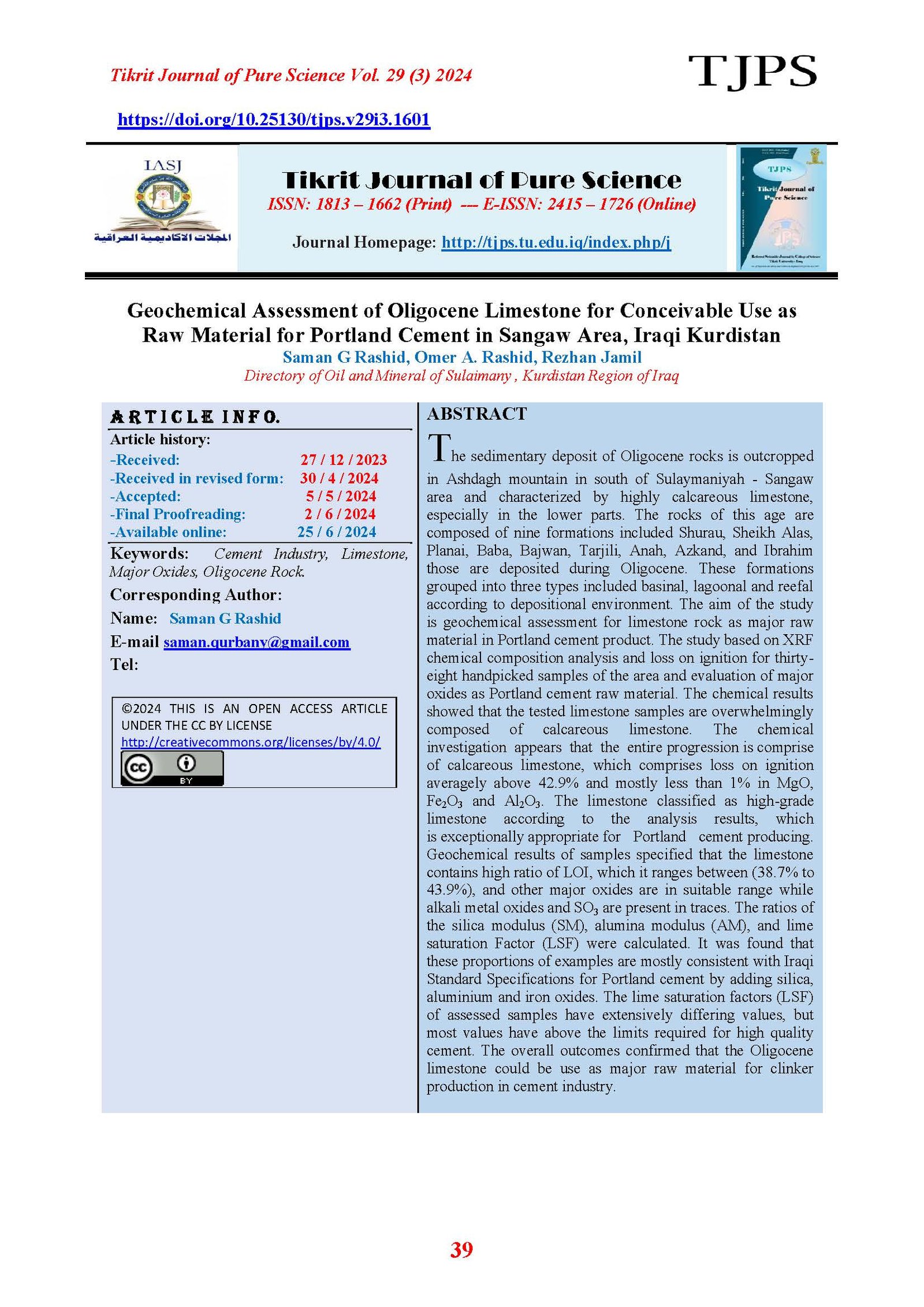Geochemical Assessment of Oligocene Limestone for Conceivable Use as Raw Material for Portland Cement in Sangaw Area, Iraqi Kurdistan Geochemical Assessment of Oligocene Limestone for Conceivable Use as Raw Material for Portland Cement in Sangaw Area, Iraqi Kurdistan
Main Article Content
Abstract
The sedimentary deposit of Oligocene rocks is outcropped in Ashdagh mountain in south of Sulaymaniyah - Sangaw area and characterized by highly calcareous limestone, especially in the lower parts. The rocks of this age are composed of nine formations included Shurau, Sheikh Alas, Planai, Baba, Bajwan, Tarjili, Anah, Azkand, and Ibrahim those are deposited during Oligocene. These formations grouped into three types included basinal, lagoonal and reefal according to depositional environment. The aim of the study is geochemical assessment for limestone rock as major raw material in Portland cement product. The study based on XRF chemical composition analysis and loss on ignition for thirty-eight handpicked samples of the area and evaluation of major oxides as Portland cement raw material. The chemical results showed that the tested limestone samples are overwhelmingly composed of calcareous limestone. The chemical investigation appears that the entire progression is comprise of calcareous limestone, which comprises loss on ignition averagely above 42.9% and mostly less than 1% in MgO, Fe2O3 and Al2O3. The limestone classified as high-grade limestone according to the analysis results, which is exceptionally appropriate for Portland cement producing. Geochemical results of samples specified that the limestone contains high ratio of LOI, which it ranges between (38.7% to 43.9%), and other major oxides are in suitable range while alkali metal oxides and SO3 are present in traces. The ratios of the silica modulus (SM), alumina modulus (AM), and lime saturation Factor (LSF) were calculated. It was found that these proportions of examples are mostly consistent with Iraqi Standard Specifications for Portland cement by adding silica, aluminium and iron oxides. The lime saturation factors (LSF) of assessed samples have extensively differing values, but most values have above the limits required for high quality cement. The overall outcomes confirmed that the Oligocene limestone could be use as major raw material for clinker production in cement industry.
Article Details

This work is licensed under a Creative Commons Attribution 4.0 International License.
Tikrit Journal of Pure Science is licensed under the Creative Commons Attribution 4.0 International License, which allows users to copy, create extracts, abstracts, and new works from the article, alter and revise the article, and make commercial use of the article (including reuse and/or resale of the article by commercial entities), provided the user gives appropriate credit (with a link to the formal publication through the relevant DOI), provides a link to the license, indicates if changes were made, and the licensor is not represented as endorsing the use made of the work. The authors hold the copyright for their published work on the Tikrit J. Pure Sci. website, while Tikrit J. Pure Sci. is responsible for appreciate citation of their work, which is released under CC-BY-4.0, enabling the unrestricted use, distribution, and reproduction of an article in any medium, provided that the original work is properly cited.
References
[1] Lea F. M. "Chemistry of Cement and Concrete", Third Edition, Edward Arnold (Publishers) Ltd., U.K. (1976). [2] Hussein, S. A. (2012). Study the Suitability of Limestone in Fat'ha Formation for Cement Manufacturing in Selected Quarries, between Qasr Al-Jabbar and Musallakhah Village Depending on Geochemical, Mineralogical and Petrophysical Criterion. Tikrit Journal of Pure Science, 17(3). [3] Duda, W. H."Cement –Data Book’’ International process engineering in the cement industry,3rded”: Bauverlag, GmbH, Wiesbaden and Berlin, Macdonald and Evans, London, 636P. (1985).
[4] Jassim, S.Z. Goff, J.C."Geology of Iraq": published by Dolin, Prague and Moravian Museum, Brno, 341p.(2006) Duda, W.H. (1988) Cement Data Book. Vol.1. Bauverlag GmbH, Berlin. [5] Kharajiany S. O. A., (2008): Sedimentary facies of Oligocene rock units in Ashdagh mountain- Sangaw district- Kurdistan region-NE Iraq, Unpublished thesis, College of Science, University of Sulaimani. [6] Cox, F. C., Bridge, D., & Hull, J. H. (1977). Procedure for the assessment of limestone resources. British Geological Survey. [7] Austin G. T., Shreve’s Chemical ProcessIndustries, 5 th ed. 1985, Singapore: McGrawHill Book Company. [8] Neville A.M., Concrete Technology, 4 th ed.1996, Singapore: Long man Singapore Publishers Ltd. [9] Fatah, C. M., Karim K.H, and Mirza. T.A., (2020), Geological study of Aqra Formation for possible use as Portland cement in Chwarta-Mawat area Sulaimani – Iraqi Kurdistan Region, published JZS-A Volume 22, Issue 1. [10] Rao, D. S., Vijayakumar, T. V., Prabhakar, S., & Bhaskar Raju, G. (2011). Geochemical assessment of a siliceous limestone sample for cement making. Chinese Journal of geochemistry, 30(1), 33-39.
[11] Chatterjee, A. K., 2004. Raw materials selection. innovation in Portland cement manufacturing Portland cement association, Illinois, USA, pp. 37-63.
[12] CCNN - Sokoto. (2009). Cement Operation Course 2009. Sokoto: Isaksson - Taylor. Cement Company of Northern Nigeria PLC, Sokoto. (2013, 2016). Cement Milling. Sokoto.
[13] IQS, No.5 (2019). Iraqi standard specification, Portland cement. (In Arabic). [14] Mirza, T. A., Mohialdeen, I. M., Al-Hakarri, S. H., & Fatah, C. M. (2016). Geochemical assessment of Naopurdan limestone for cement making-Chwarta area, Kurdistan Region, NE Iraq. Journal of Zankoy Sulaimani Part-A-(Pure and Applied Sciences), Special Issue, GeoKurdistan II, 257-267.
[15] Nayak B.D. and Mallik P.K. (2002) Characterisation of Portland cement clinker manufactured by down draft sintering and vertical shaft kiln processes [J]. Advances incement Research. 14, 1-7.
[16] Taylor, H.W. (1990) Cement Chemistry. Academic Press Publishers, London. [17] Ahmed, K. M., Faisal, S. H., & Hassan, F. N. (2022). Assessment limestone of Ghar Formation in Al-Busaiyah Area in southern Iraq, as Raw Materials for the Manufacture of ordinary Portland cement (OPC). Tikrit Journal of Pure Science, 27(2), 23-33.
